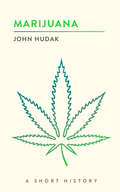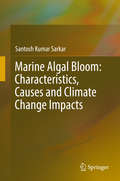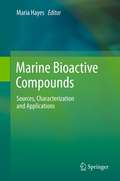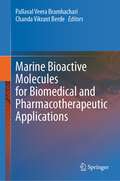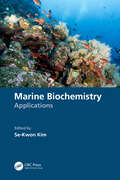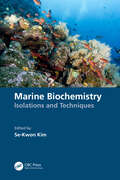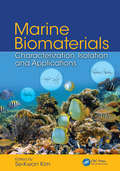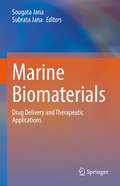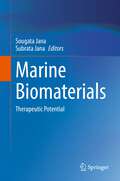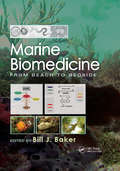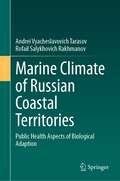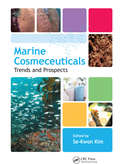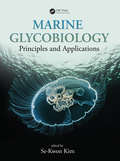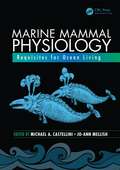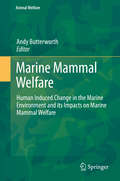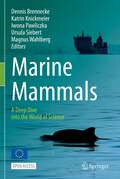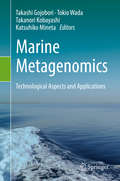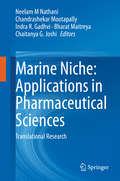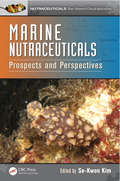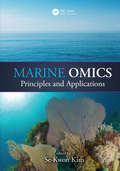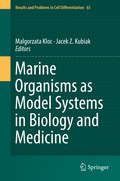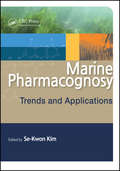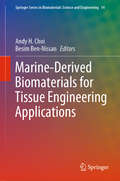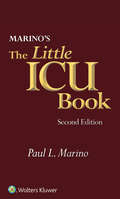- Table View
- List View
Marijuana: A Short History
by John HudakFrom Reefer Madness to legal purchase at the corner store.With long-time legal and social barriers to marijuana falling across much of the United States, the time has come for an accessible and informative look at attitudes toward the dried byproduct of Cannabis sativa. Marijuana: A Short History profiles the politics and policies concerning the five-leaf plant in the United States and around the world.Millions of Americans have used marijuana at some point in their lives, yet it remains a substance shrouded by myth, misinformation, and mystery. This book offers an up-to-date, cutting-edge look at how a plant with a tumultuous history has emerged from the shadows of counterculture and illegality. Today, marijuana has become a remarkable social, economic, and even political force, with a surprising range of advocates and opponents. Public policy toward marijuana, especially in the United States, is changing rapidly. Marijuana: A Short History provides a brief yet compelling narrative that discusses the social and cultural history of marijuana but also tells us how a once-vilified plant has been transformed into a serious, even mainstream, public policy issue. Focusing on politics, the media, government, and education, the book describes why public policy has changed, and what that change might mean for marijuana's future place in society.
Marine Algal Bloom: Characteristics, Causes and Climate Change Impacts
by Santosh Kumar SarkarIn the marine environment, single-celled, microscopic, plant-like organisms naturally occur in the well-lit surface layer of any body of water. These organisms, referred to as phytoplankton or microalgae, form the base of the food web upon which nearly all other marine organisms depend. Algal bloom is a rapid increase in or accumulation of the population of about 300 species of algae due to excess nutrients (eutrophication), and is of major global interest as it causes reduction in species diversity, abrupt changes in water quality, and discoloration of the water (green, yellow, brown or red) depending on the species of algae and the type of pigments they contain. Dying blooms can also be an environmental concern as when the cells sink and decay, bacteria break down the organic material, which in turn strips oxygen from the water. This microbial oxygen demand at times leads to very low oxygen levels in the bottom waters, harming aquatic life. Documentation of this sporadic high abundance of algae, together with the significant species richness of the diatoms, requires comprehensive studies in the Sundarban coastal environment, which is facing severe degradation due to natural & anthropogenic stressors. In addition, a better understanding of the effects of algal blooms on seafood quality, the complex biological, chemical and physical interactions and subsequent effects on trophodynamics is needed to develop strategies for effective coastal zone management. The book discusses the occurrence of harmful algal blooms (HABs) caused by the dinoflagellates of the genus Alexandrium and Karenia, or diatoms of the genus Pseudo-nitzschia, which have large and varied impacts on marine ecosystems (such as large-scale marine mortality events that have been associated with various types of shellfish poisonings) depending on the species involved, the environment where they are found, and the mechanism by which they exert negative effects. HABs represent a major environmental problem in all regions of the U.S., and their occurrence is on the rise due to increased nutrient pollution. HABs have severe impacts on human health, aquatic ecosystems, and the economy. Such blooms, known colloquially as red tides due to their red or brown hues, are increasing in frequency and magnitude worldwide as a result of changes in oceanic climate, increased coastal eutrophication and enhanced long-distance dispersal in ballast water. As such, the book offers an in-depth account of the complex biological, chemical and physical interactions of the algal blooms (both innocuous and harmful ones). It also discusses the highly topical issue of the impact of global climate change on the frequency and severity of HABs in the context of alterations in temperature, stratification, light and ocean acidification.Focusing on both basic and applied limnology, this book is a reliable and up-to-date reference resource for students, teachers and researchers engaged in the field of coastal research/management at regional and global scales.
Marine Bioactive Compounds
by Maria HayesThe aim and scope of this book is to highlight the sources, isolation, characterization and applications of bioactive compounds from the marine environment and to discuss how marine bioactive compounds represent a major market application in food and other industries. It discusses sustainable marine resources of macroalgal origin and gives examples of bioactive compounds isolated from these and other resources, including marine by-product and fisheries waste streams. In addition, it looks at the importance of correct taxonomic characterization.
Marine Bioactive Molecules for Biomedical and Pharmacotherapeutic Applications
by Pallaval Veera Bramhachari Chanda Vikrant BerdeThis book explores cutting-edge research on the discovery and application of marine bioactive molecules for biomedical and pharmacotherapeutic purposes. The book begins by delving into the bioprospection of marine sponge microbiomes for bioactive metabolites using advanced metagenomics tools. It then explores metagenome mining approaches for the discovery of marine microbial natural products. The use of marine-derived fungi as a source of anticancer secondary metabolites is also discussed. The book then turns to the biomedical applications of marine-derived biomaterials, including marine biopolymers in tissue engineering and regenerative medicine. Marine-derived pharmaceuticals and polymeric nanostructures for cancer treatment are also examined. Next, the book looks at the use of marine microbial sources for the synthesis of metallic nanomaterials, prospects, current development, and challenges in nanomedicine. The book continues by exploring the treasure trove of natural polymers for tissue engineering in the marine environment. It also discusses the immunomodulatory and therapeutic potential of marine-derived astaxanthin, current developments, and prospects. Finally, the book concludes by exploring the recent progress in marine-derived nutraceuticals and marine phytoplankton bioactive compounds and their applications in medicine.
Marine Biochemistry: Applications
by Se-Kwon KimThis book provides the latest comprehensive methods for isolation and other novel techniques for marine product development. Furthermore, this book offers knowledge on the biological, medical, and industrial applications of marine-derived medicinal food substances. There has been a tremendous increase in the products derived from marine organisms for commercial application in industries every year. Functional foods of medicinal value are particularly in demand as new technology allows the stabilization of natural ingredients and their availability in pure forms to solve various human diseases. Marine flora and fauna have essential elements and trace minerals that nurture various hormones produced in the endocrine system to regulate the respective metabolisms, thereby providing a safe and healthy life to humans. The overall presentation and clear demarcation of the contents by worldwide contributions is a novel entry point into the market of medicinal foods from the sea. The exploration of marine habitats for novel materials are discussed throughout the book. The exploration and exploitation of the biochemistry of sea flora and fauna are limited, and this book extends the research possibilities into numerous marine habitats. Various approaches for extracting and applying the flora and fauna are discussed. This book will be of value to researchers, marine biotechnologists, and medical practitioners, due to the vast information, as well as industrial and medical applications of marine substances all in one place.
Marine Biochemistry: Isolations and Techniques
by Se-Kwon KimThis book provides the latest comprehensive methods for isolation and other novel techniques for marine product development. Furthermore, this book offers knowledge on the biological, medical, and industrial applications of marine-derived medicinal food substances. There has been a tremendous increase in the products derived from marine organisms for commercial application in industries every year. Functional foods of medicinal value are particularly in demand as new technology allows the stabilization of natural ingredients and their availability in pure forms to solve various human diseases. Marine flora and fauna have essential elements and trace minerals that nurture various hormones produced in the endocrine system to regulate the respective metabolisms, thereby providing a safe and healthy life to humans. The overall presentation and clear demarcation of the contents by worldwide contributions is a novel entry point into the market of medicinal foods from the sea. The exploration of marine habitats for novel materials are discussed throughout the book. The exploration and exploitation of the biochemistry of sea flora and fauna are limited, and this book extends the research possibilities into numerous marine habitats. Various approaches for extracting and applying the flora and fauna are discussed. This book will be of value to researchers, marine biotechnologists, and medical practitioners, due to the vast information, as well as industrial and medical applications of marine substances all in one place.
Marine Biomaterials: Characterization, Isolation and Applications
by Se-Kwon KimOceans are an abundant source of diverse biomaterials with potential for an array of uses. Marine Biomaterials: Characterization, Isolation and Applications brings together the wide range of research in this important area, including the latest developments and applications, from preliminary research to clinical trials. The book is divided into fou
Marine Biomaterials: Drug Delivery and Therapeutic Applications
by Sougata Jana Subrata JanaThis book is focused on marine based biomedical carriers for delivery of therapeutics. Marine biomaterials and bio-based carriers show wide applications in pharmaceutical as well as biomedical fields for delivery of small and large molecules. Biomaterial-based composites, scaffolds or matrix systems are promising systems for controlled and prolonged release of drug in target site and control the premature release of drugs or bioactive compounds. This book discusses the targeted delivery of drugs and therapeutic applications. It also describes the use of marine biopolymers in cancer therapy. Different chapters describe the tissue engineering techniques to develop these carriers. The marine biomaterial-based systems are widely used for tissue engineering, and biomedical imaging. This book is meant for industry experts, students and researchers in the area of pharmaceutical sciences, biomedical engineering and material science and pharmacology.
Marine Biomaterials: Therapeutic Potential
by Sougata Jana Subrata JanaThis book provides updated information on marine-based biomedical carriers and their therapeutic potential. Marine biomaterials and bio-based carriers show wide application in pharmaceutical and biomedical fields to deliver small and large molecules. Biomaterial-based composites, scaffolds, or matrix systems are sound systems for controlled and prolonged drug release in target sites and control the premature release of drugs or bioactive compounds. This book discusses essential topics such as the therapeutic potential of marine collagen, management of bone disorders, gene delivery, natural marine compounds in immunomodulation, theranostic applications, tissue engineering, and regeneration. It also describes the use of marine biopolymers in cancer therapy. Different chapters describe the tissue engineering techniques to develop these carriers. Marine biomaterial-based systems are popular for tissue engineering and biomedical imaging.This book is ideal for industry experts, students, and researchers in pharmaceutical sciences and pharmacology.
Marine Biomedicine: From Beach to Bedside
by Bill J. BakerMarine Biomedicine: From Beach to Bedside assesses current efforts in marine biomedicine and evaluates the implications of recent advances on the future of the field.Richly illustrated in full color to enhance reader comprehension, the book covers four sections. The first one addresses the technology that has recently been brought to bear on the st
Marine Climate of Russian Coastal Territories: Public Health Aspects of Biological Adaption
by Andrei Vyacheslavovich Tarasov Rofail Salykhovich RakhmanovThe monograph was written based on the material of the post-doctoral thesis prepared under the supervision of Prof. Dr. Rakhmanov and it has been translated from its original version in Russian. It presents a comprehensive analysis of the process of biological adaptation and adaptation capacity of the population to the marine climate of Russia’s North, the Black and Caspian Sea regions and the Baltic Sea coast. The authors explore different biological reactions to adaptation and offer their classification depending on the type of climate. Special attention is given to the prevention of prenosological conditions and diseases typical of coastal areas. Evidence suggests that the human body has a remarkable capacity to adapt to a range of climatic and weather conditions through a variety of targeted adaptation measures.
Marine Cosmeceuticals: Trends and Prospects
by Se-Kwon KimMarine Cosmeceuticals: Trends and Prospects is a consolidated overview of the marine environment as a productive source of novel cosmeceuticals. It accumulates the latest research in this field from around the globe, highlighting the potential of marine micro and macro flora and fauna as effective agents for the development of novel cosmeceuticals.
Marine Glycobiology: Principles and Applications
by Se-Kwon KimMarine glycobiology is an emerging and exciting area in the field of science and medicine. Glycobiology, the study of the structure and function of carbohydrates and carbohydrate-containing molecules, is fundamental to all biological systems and represents a developing field of science that has made huge advances in the last half-century. This book revolutionizes the concept of marine glycobiology, focusing on the latest principles and applications of marine glycobiology and their relationships.
Marine Mammal Physiology: Requisites for Ocean Living (CRC Marine Biology Series)
by Michael A. Castellini Jo-Ann MellishSuppose you were designing a marine mammal. What would you need to think about to allow it to live in the ocean? How would you keep it warm? What would you design to allow it to dive for very long periods to extreme depths? Where would it find water to drink? How would you minimize the cost of swimming, and how would it find its prey in the deep an
Marine Mammal Welfare
by Andy ButterworthMarine mammals attract human interest – sometimes this interest is benign or positive – whale watching, conservation programmes for whales, seals, otters, and efforts to clear beaches of marine debris are seen as proactive steps to support these animals. However, there are many forces operating to affect adversely the lives of whales, seals, manatees, otters and polar bears – and this book explores how the welfare of marine mammals has been affected and how they have adapted, moved, responded and sometimes suffered as a result of the changing marine and human world around them. Marine mammal welfare addresses the welfare effects of marine debris, of human traffic in the oceans, of noise, of hunting, of whale watching and tourism, and of some of the less obvious impacts on marine mammals – on their social structures, on their behaviours and migration, and also of the effects on captivity for animals kept in zoos and aquaria. There is much to think and talk about – how marine mammals respond in a world dramatically influenced by man, how are their social structures affected and how is their welfare impacted?
Marine Mammals: A Deep Dive into the World of Science
by Dennis Brennecke Katrin Knickmeier Iwona Pawliczka Ursula Siebert Magnus WahlbergThis highly-readable Open Access textbook provides basic background information about marine mammals and anthropogenic impacts on them. The book includes inspiring exercises for education school programs in natural sciences. The book also provides advice on career paths using case studies of marine scientists and veterinarians describing their journeys from student to profession. By sharing real-life career paths, readers find answers to questions such as “What needs to be considered when choosing a career in science?” and “What kind of tasks do scientists undertake on a daily basis?” Marine mammals are amongst some of the most celebrated creatures on Earth, with their high intelligence, social and communicating skills, and capacity for deep diving. Alongside general information about marine mammals, the book aims at generating awareness of the impact of litter and noise pollution on the marine environment using marine mammals as an example. Huge numbers of marine animals, including marine mammals, die every year from entanglement in fishing gear, by ingestion of litter or because of chemical pollution. In the last decade many technological and scientific tools have been developed to aid research, for instance miniaturised sound recorders which can be attached to cetaceans and seals and record noise levels around them, their vocal production as well as their diving behaviour. This Open Access textbook can be used by undergraduate students interested in the fundamentals of marine mammal biology and medicine, and in pursuing the profession of a marine scientist.
Marine Metagenomics: Technological Aspects and Applications
by Takashi Gojobori Tokio Wada Takanori Kobayashi Katsuhiko MinetaThis book presents the state-of-art marine metagenome research and explains the method of marine metagenomic analysis in an easy-to-understand manner.Changes in the marine environment due to global warming and pollution have become a major global problem. Maintaining a healthy marine ecosystem requires advanced environmental monitoring and assessment systems. As such, the book presents a novel metagenomic monitoring method, which has been developed for comprehensive analyses of the DNA of microorganisms living in seawater to further our understanding of the dynamics of the marine environment. The book can be used as a primer for new researchers and as a manual on experimental methods.
Marine Niche: Translational Research
by Chaitanya G. Joshi Neelam M Nathani Chandrashekar Mootapally Indra R. Gadhvi Bharat MaitreyaThis book offers a comprehensive study of biological molecules acquired from marine organisms, which have been exploited for drug discovery with the aim to treat human diseases. Biomolecules have potential impacts on a diverse range of fields, including medical and pharmaceutical science, industrial science, biotechnology, basic research, molecular science, environmental science and climate change, etc. To understand and effectively apply medicinally important biomolecules, multidisciplinary approaches are called for. The ocean remains a rich biological resource, and the vast untapped potential of novel molecules from marine bio-resources has caught the interest of more and more researchers. These novel biological compounds have never been found in terrestrial or other ecosystems, but only in this rich niche. Advances in sampling techniques and technologies, along with increased funding for research and nature conservation, have now encouraged scientists to look deeper in the waters. Aquaculture supports both tremendous seafood production and the bulk production of marine-derived drugs. Furthermore, molecular methods are now being extensively employed to explore the untapped marine microbial diversity. With the help of molecular and biotech tools, the ability of marine organisms to produce new biosynthetic drugs can be greatly enhanced. This book provides an extensive compilation of the latest information on marine resources and their undisputedly vital role in the treatment of diverse ailments.
Marine Nutraceuticals: Prospects and Perspectives (Nutraceuticals)
by Se-Kwon KimThere is a great deal of consumer interest in natural bioactive substances due to their health benefits. Offering the potential to provide valuable nutraceuticals and functional food ingredients, marine-derived compounds are an abundant source of nutritionally and pharmacologically active agents, with both chemical diversity and complexity. Functio
Marine OMICS: Principles and Applications
by Se-Kwon KimThis book provides comprehensive coverage on current trends in marine omics of various relevant topics such as genomics, lipidomics, proteomics, foodomics, transcriptomics, metabolomics, nutrigenomics, pharmacogenomics and toxicogenomics as related to and applied to marine biotechnology, molecular biology, marine biology, marine microbiology, environmental biotechnology, environmental science, aquaculture, pharmaceutical science and bioprocess engineering.
Marine Organisms as Model Systems in Biology and Medicine (Results and Problems in Cell Differentiation #65)
by Jacek Z. Kubiak Malgorzata KlocThis book highlights the potential advantages of using marine invertebrates like tunicates, echinoderms, sponges and cephalopods as models in both biological and medical research. Bioactive compounds found in marine organisms possess antibacterial, antifungal, anti-diabetic and anti-inflammatory properties, and can affect the immune and nervous systems. Despite substantial research on the medicinal attributes of various marine invertebrates, they are still very much underrepresented in scientific literature: the majority of cell, developmental and evolutionary scientific journals only publish research conducted on a few well-known model systems like Drosophila melanogaster or Xenopus laevis. Addressing that gap, this book introduces readers to new model organisms like starfish or nemertera. By showing their benefits with regard to regeneration, stem cell research and Evo-Devo, the authors provide a cross-sectional view encompassing various disciplines of biological research. As such, this book will not only appeal to scientists currently working on marine organisms, but will also inspire future generations to pursue research of their own.
Marine Pharmacognosy: Trends and Applications
by Se-Kwon KimDiverse and abundant, marine-derived bioactive compounds offer a plethora of pharmacologically active agents with the potential to produce valuable therapeutic entities. Marine-derived organisms, including some macroalgae, microalgae, blue-green algae, invertebrates, and vertebrates-valued in traditional Chinese medicine since ancient times-are now
Marine-Derived Biomaterials for Tissue Engineering Applications (Springer Series in Biomaterials Science and Engineering #14)
by Besim Ben-Nissan Andy H. ChoiThis book presents the latest advances in marine structures and related biomaterials for applications in both soft- and hard-tissue engineering, as well as controlled drug delivery. It explores marine structures consisting of materials with a wide variety of characteristics that warrant their use as biomaterials. It also underlines the importance of exploiting natural marine resources for the sustainable development of novel biomaterials and discusses the resulting environmental and economic benefits. The book is divided into three major sections: the first covers the clinical application of marine biomaterials for drug delivery in tissue engineering, while the other two examine the clinical significance of marine structures in soft- and hard-tissue engineering, respectively. Focusing on clinically oriented applications, it is a valuable resource for dentists, oral and maxillofacial surgeons, orthopedic surgeons, and students and researchers in the field of tissue engineering.
Marino's The Little ICU Book
by Paul L. Marino Samuel M. GalvagnoQuick lookup for the most essential info in critical care! Ideal for quick reference at the bedside, The Little ICU Book is a condensed, compact version of The ICU Book, Dr. Marino’s best-selling comprehensive intensive care reference.The Little ICU Book zeroes in on only the essentials for the hands-on care of critically ill adult patients. Its fast-access format makes it an indispensible resource for residents as well as busy critical care physicians.
Marital Conflict and Children
by Patrick Davies E. Mark CummingsFrom leading researchers, this book presents important advances in understanding how growing up in a discordant family affects child adjustment, the factors that make certain children more vulnerable than others, and what can be done to help. It is a state-of-the-science follow-up to the authors' seminal earlier work, Children and Marital Conflict The Impact of Family Dispute and Resolution. The volume presents a new conceptual framework that draws on current knowledge about family processes; parenting; attachment; and children's emotional, physiological, cognitive, and behavioral development. Innovative research methods are explained and promising directions for clinical practice with children and families are discussed.
